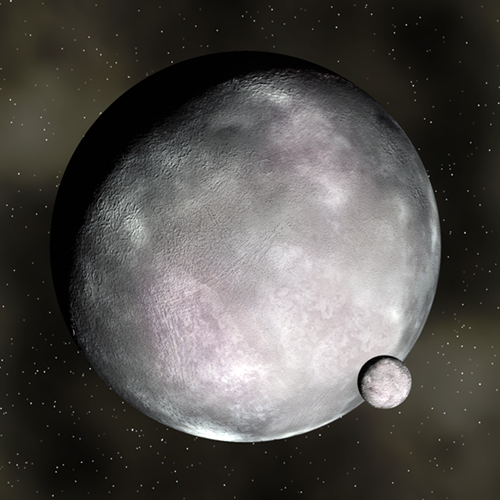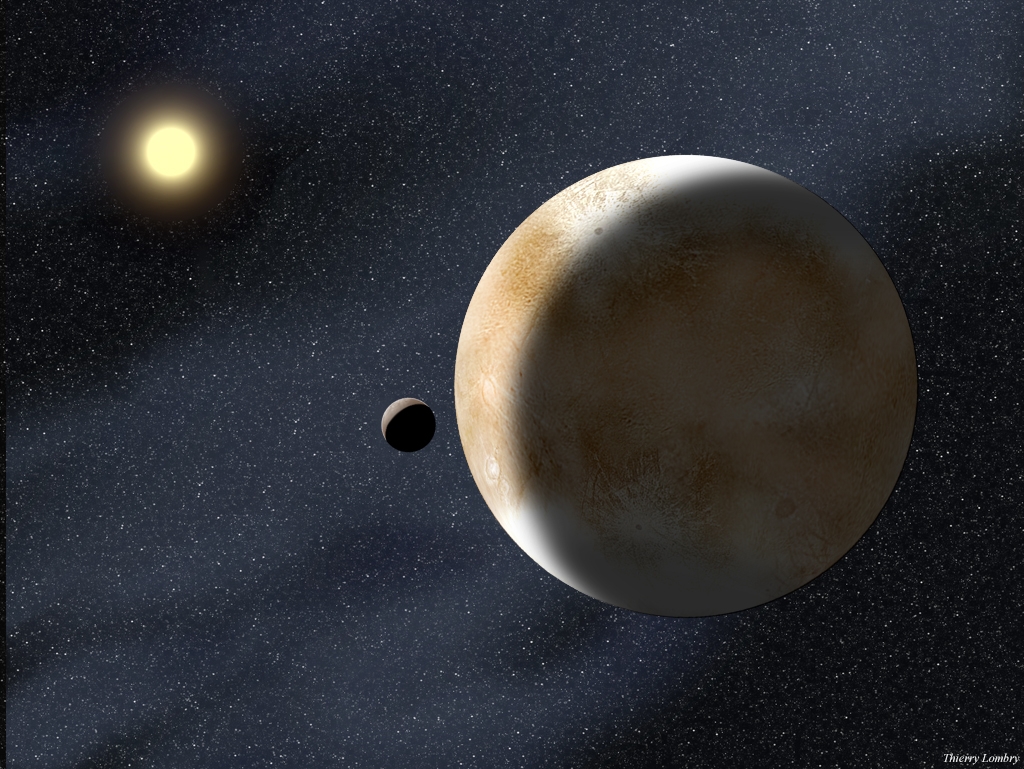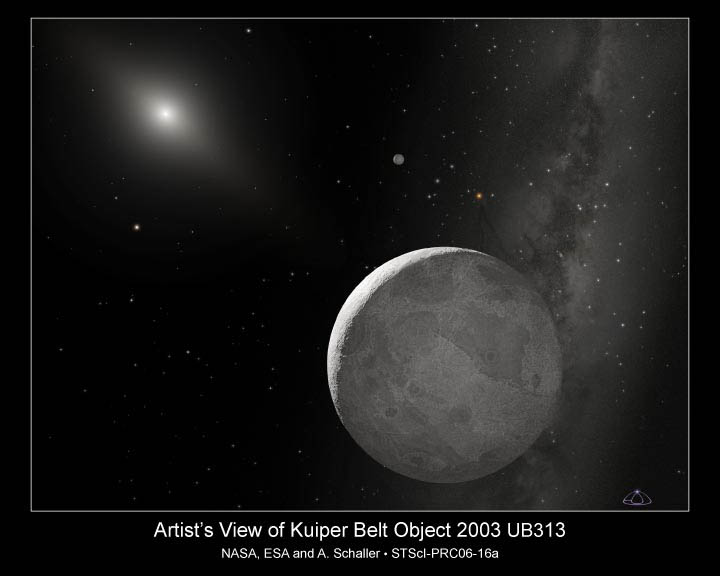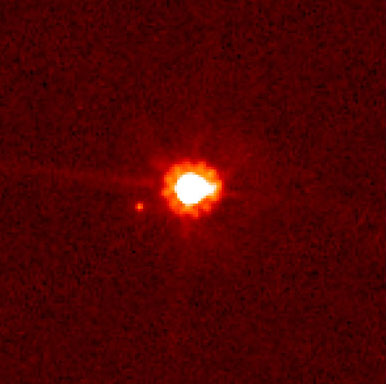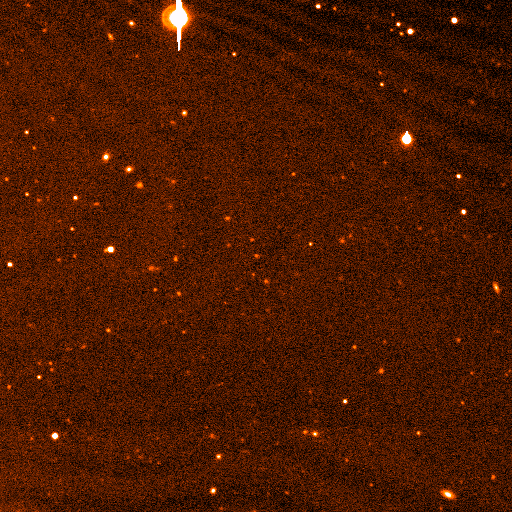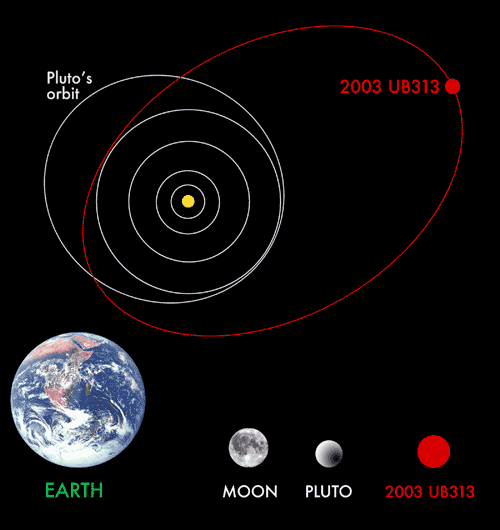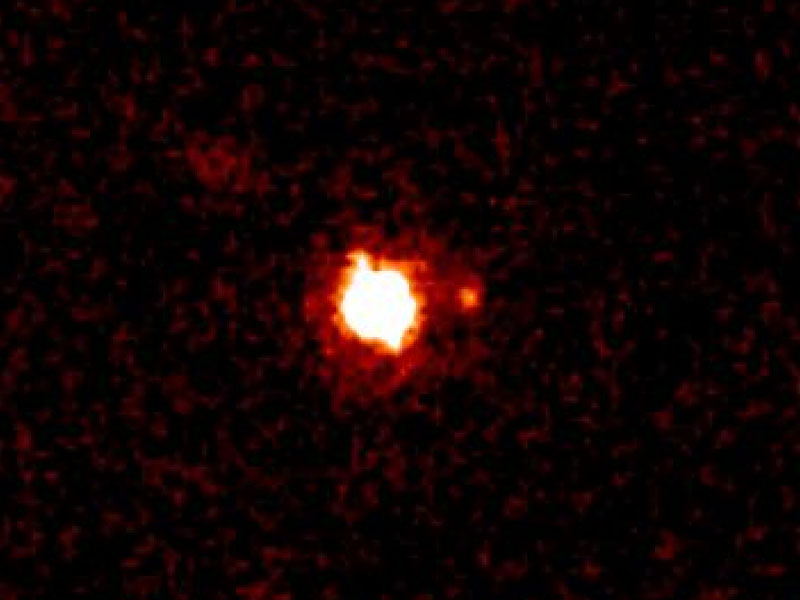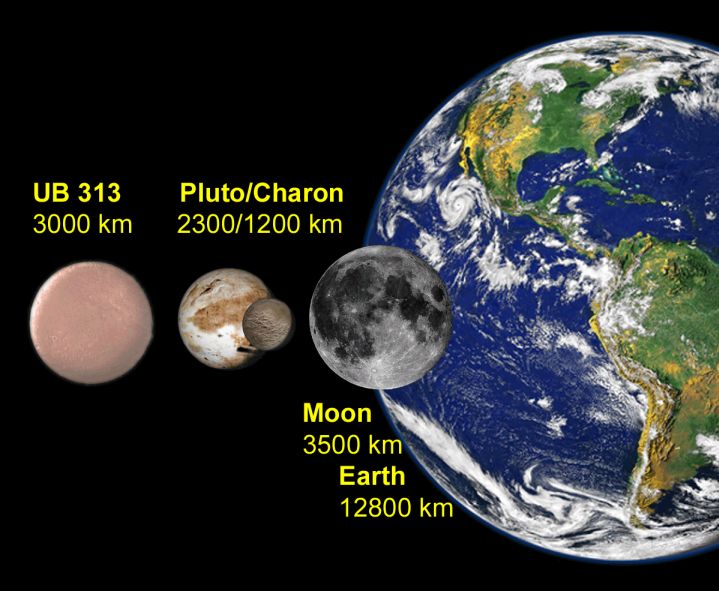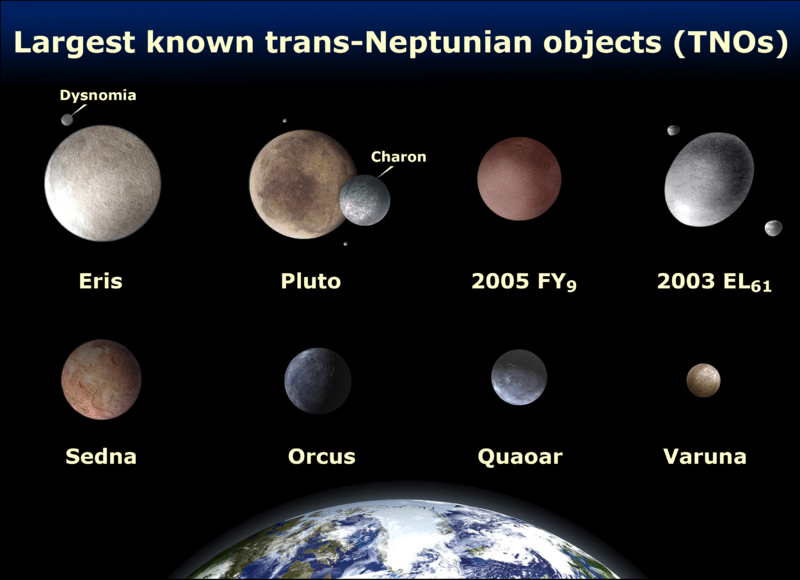|
Enigmas in Our Solar System New Planets Discovered |
||
|
(formerly Xena and Gabrielle) ..
by Francis Reddy
September 30, a team led by Caltech's Michael Brown announced discovery of a moon orbiting the distant body 2003 UB313. The object, discovered in January 2005, appears to be 20-percent larger than Pluto, leading Brown to dub it the tenth planet. The team has given it the unofficial nickname "Xena," after the lead character in the TV series Xena: Warrior Princess. "Since the day we discovered Xena, the big question has been whether or not it has a moon," says Brown. "Having a moon is just inherently cool ? and it is something that most self-respecting planets have, so it is good to see that this one does too." The moon, nicknamed "Gabrielle" after the fictional Xena's traveling companion, orbits 2003 UB313 about every 14 days. It's thought to be about 155 miles (250 kilometers) across, or about 9-percent Xena's size. The moon's presence "is the only way we could ever measure the mass of Xena," explains Brown. "A combination of the distance of the moon from the planet and the speed it goes around the planet tells you very precisely what the mass of the planet is." Brown and his colleagues will track Gabrielle's motion with the Hubble Space Telescope in November and December, will yield a precise orbit for the moon. The team found the moon using the newly installed Laser Guide Star Adaptive Optics system on the Keck II Telescope in Hawaii. The system creates an artificial star in an atmospheric layer about 75 miles (120 km) high, then monitors this point for cues to compensate for blurring caused by atmospheric turbulence. The system makes faint detections possible because "observers not only get more resolution, but the light from distant objects is concentrated over a much smaller area," says team member Marcos van Dam, a scientist at the W. M. Keck Observatory. "At first we saw this little faint thing that kept cropping up in all the images, and we knew it was not a background star or galaxy because it moved across the sky with the primary," van Dam explains. "By morning, we knew that we had made a major discovery." Xena and Gabrielle, along with Pluto and its moon Charon, orbit in the Kuiper Belt, a swath of icy bodies that stretches from just beyond Neptune to the distant fringes of the solar system. In July, when Brown's team went public with Xena, the astronomers also announced two other new Kuiper Belt objects ? 2005 FY9 (codenamed "Easterbunny" until a formal moniker is approved) and 2003 EL61 ("Santa"). Both are thought to be about three-fourths Pluto's size, and 2003 EL61 also has a moon ("Rudolph"). Together with Xena and Pluto, they represent the Kuiper Belt's four brightest members. "Pluto once seemed a unique oddball at the fringe of the solar system," Brown says. "But we now see that Xena, Pluto, and the others are part of a diverse family of large objects with similar characteristics, histories, and even moons, which together will teach us much more about the solar system than any single oddball ever would." In a paper submitted October 2 to Astrophysical Journal Letters, Brown and his colleagues say the very presence of moons around three of the four brightest ? and presumably largest ? Kuiper Belt objects makes this group unusual. A recent Hubble survey of 81 objects in the Kuiper Belt turned up only nine satellites. Moreover, says the team, the moons of Xena and 2003 EL61 are much fainter and smaller in relation to their primary bodies than other satellites in the region. "We were surprised because this is a completely different type of satellite from anything we've seen before," Brown says. The astronomers suggest the moons formed in a manner different from the gravitational capture envisioned for most Kuiper Belt satellites. Instead, they think the moons formed in a process similar to that credited with creating Earth's Moon ? a giant impact that created a cloud of debris from which the satellite condensed. Simulations suggest this may be the best explanation for the origin of Pluto's Charon, too. "When we test collision models to predict how Pluto and Charon formed, the models kept producing tiny satellites, much smaller than Charon," Brown says. "But we had never seen satellites that small before in the Kuiper belt. But then we found a moon in the Santa system, and then we found another moon circling Xena, and they both look very similar to one another. This leads us to conclude that the largest objects in the Kuiper Belt may have been subject to collisions." The discovery of the moon's primary, Xena, was announced July 29 by Brown, Chad Trujillo of Gemini Observatory, and David Rabinowitz of Yale University. It is now about 9 billion miles (14.5 billion km) away, or about 97 times Earth's distance from the Sun, and takes 560 years to complete one orbit. The code names Xena,
Gabrielle, and others are unofficial
names the astronomers use as a shorthand for the
objects' prosaic and polysyllabic
official designations. The astronomers have
submitted official names to
the International Astronomical Union (IAU), which
approves nomenclature
in the solar system.
Copyright 2002-2006 by Francis Reddy. All rights reserved; see terms of use. SOURCE: Celestial Delights: The "Tenth Planet" Gets a Sidekick |
||
| Planet Xena no
Longer Xena,
nor Planet
Thursday, 14 September 2006 by Erica Harrison, Cosmos Online Excerpt SYDNEY, 14 September 2006: The distant, icy rock, whose discovery led to Pluto being stripped of its planethood has been officially named 'Eris'. The christening was announced yesterday by the International Astronomical Union (IAU), on the same day they gave Pluto the unremarkable moniker of 134340 Pluto, according to early reports from Associated Press. Discovered in July last year, Eris – which is larger than Pluto - ignited a fierce debate over exactly what constitutes a planet. In the fallout, Pluto was demoted to the less prestigious rank of 'dwarf planet'. The new category of celestial body also includes Eris and the asteroid Ceres. Appropriately, the controversial lump of rock and ice has been named after the Greek goddess of chaos and strife. The new name replaces the temporary tag chosen by its discoverers: Xena, in honour of the lead character in the cult TV series, Xena: Warrior Princess. SOURCE: Cosmos Online |
||
|
..
Explanation: Eris, a dwarf planet currently orbiting the Sun at about twice Pluto's distance, has been measured to have about 27 percent more mass than Pluto. The mass was calculated by timing the orbit of Eris' moon Dysnomia. Images taken with a ground-based Keck telescope, when combined with existing images taken by Hubble Space Telescope, show that Dysnomia has a nearly circular orbit lasting about 16 days. Cataloged as 2003 UB313 only a year ago, infrared images also showed previously that Eris is actually larger in diameter than Pluto. The plane of Eris' orbit is well out of the plane of the Solar System's planets. In the above drawing, a scientific artist has imagined Eris and Dysnomia orbiting our distant Sun. No space missions are currently planned to Eris, although the robotic New Horizons spacecraft bound for Pluto has recently passed Jupiter. Authors & editors: Robert
Nemiroff (MTU)
& Jerry Bonnell (USRA)
SOURCE: NASA APOD ap070619 |
||
| Hubble Finds
'Tenth Planet'
is Slightly Larger than Pluto
The full news release story: http://hubblesite.org/newscenter/archive/releases/2006/16/full/
NASA's Hubble Space Telescope has resolved the "tenth planet," nicknamed "Xena" for the first time, and has found that it is only just a little larger than Pluto. Though previous ground-based observations suggested that Xena was about 30 percent greater in diameter than Pluto, Hubble observations taken on Dec. 9 and 10, 2005, yield a diameter of 1,490 miles (with an uncertainty of 60 miles) for Xena. Pluto's diameter, as measured by Hubble, is 1,422 miles. "Hubble is the only telescope capable of getting a clean visible-light measurement of the actual diameter of Xena," said Mike Brown, planetary scientist at the California Institute of Technology in Pasadena, Calif. Brown's research team discovered Xena, and their results have been accepted for publication in the Astrophysical Journal. It only required a couple of Hubble images to nail Xena's diameter. Located 10 billion miles away, but with a diameter that is a little more than half the width of the United States, the object is 1.5 pixels across in Hubble's view. That's enough to precisely make a size measurement. Because Xena is smaller than earlier thought, but comparatively bright, it must be one of the most reflective objects in the solar system. The only object more reflective is Enceladus, a geologically active moon of Saturn whose surface is continuously recoated with highly reflective ice by active geysers. Xena's bright reflectivity is possibly due to fresh methane frost overlying the surface. It is possible that Xena had an atmosphere when it was closer to the Sun, but "froze out" at its current large distance, and material settled on its surface as frost. Another possibility is that Xena is also continuously leaking methane gas from its warmer interior. When this methane makes it to the cold surface it immediately freezes solid, covering craters and other features to make this Kuiper Belt object (KBO) uniformly bright to Hubble's telescopic eye. Xena is officially catalogued as 2003 UB313. Its orbital period is about 560 years, and the KBO is now very close to aphelion (the point on its orbit that is farthest from the Sun). Brown next plans to use Hubble and other telescopes to study other recently discovered KBOs that are almost as large as Pluto and Xena. The Kuiper Belt is a vast ring of primordial icy comets and larger bodies encircling Neptune's orbit. Finding that the largest known KBO is a virtual twin to Pluto may only further complicate the debate about whether to categorize the large icy worlds that dwell in the Kuiper Belt as planets. If Pluto were considered to be the minimum size for a planet, then Xena would fulfill this criterion, too. CONTACT Ray Villard
Robert Tindol
Mike Brown
|
||
Eris (centre) and Dysnomia (left of centre), taken by the Hubble Space Telescope. Eris (dwarf planet) Eris, formally designated 136199 Eris and formerly 2003 UB313 (see minor planet names), is the largest known dwarf planet in the Solar System and the ninth largest body known to orbit the Sun directly. It is approximately 2,500 kilometres in diameter and 27% more massive than Pluto. Eris was first spotted in 2003 by a Palomar Observatory-based team led by Mike Brown but not identified until 2005. It is a trans-Neptunian object (TNO) native to a region of space beyond the Kuiper belt known as the scattered disc. Eris has one moon, Dysnomia; recent observations have found no evidence of further satellites. The current distance from the Sun is 96.7 AU, roughly three times that of Pluto. With the exception of some comets, the pair are the most distant known bodies in the Solar System. Because Eris is larger than Pluto, its discoverers and NASA called it the Solar system's tenth planet. This, along with the prospect of other similarly sized objects being discovered in the future, motivated the International Astronomical Union (IAU) to define the term "planet" for the first time. Under a new definition approved on August 24, 2006, Eris was designated a "dwarf planet" along with Pluto and Ceres. Discovery Eris was discovered by the team of Mike Brown, Chad Trujillo, and David Rabinowitz[9] on January 5, 2005, from images taken on October 21, 2003. The discovery was announced on July 29, 2005, the same day as two other large TNOs, (136108) 2003 EL61 and (136472) 2005 FY9. The search team had been systematically scanning for large outer solar system bodies for several years, and had been involved in the discovery of several other large TNOs, including 50000 Quaoar, 90482 Orcus, and 90377 Sedna. Routine observations were taken by the team on October 21, 2003, using the 1200 mm Samuel Oschin reflecting telescope at Mount Palomar Observatory, California, but the image of Eris was not discovered at that point due to its very slow motion across the sky: The team's automatic image-searching software excluded all objects moving at less than 1.5 arcseconds per hour to reduce the number of false positives returned. When Sedna was discovered, it was moving at 1.75 arcsec/h, and in light of that the team reanalyzed their old data with a lower limit on the angular motion, sorting through the previously excluded images by eye. In January 2005, the re-analysis revealed Eris' slow motion against the background stars.
Follow-up observations were then carried out to make a preliminary determination of its orbit, which allowed its distance to be estimated. The team had planned to delay announcing their discovery until further observations allowed more accurate calculations of Eris' orbit, but brought their announcement forward when the discovery of another large TNO they had been tracking, 2003 EL61, was announced by a different team in Spain.[9] More observations released in October 2005 revealed that Eris had a moon, later named Dysnomia. Observations of Dysnomia's orbit permitted scientists to determine the mass of Eris, which in June 2007 they calculated to be (1.66 ± 0.02)×1022 kg, 27% greater than Pluto. SOURCE: Wikipedia |
||
|
||
|
.
Explanation: Is Pluto the largest dwarf planet? No! Currently, the largest known dwarf planet is (136199) Eris, renamed last week from 2003 UB313. Eris is just slightly larger than Pluto, but orbits as far as twice Pluto's distance from the Sun. Eris is shown above in an image taken by a 10-meter Keck Telescope from Hawaii, USA. Like Pluto, Eris has a moon, which has been officially named by the International Astronomical Union as (136199) Eris I (Dysnomia). Dysnomia is visible above just to the right of Eris. Dwarf planets Pluto and Eris are trans-Neptunian objects that orbit in the Kuiper belt of objects past Neptune. Eris was discovered in 2003, and is likely composed of frozen water-ice and methane. Since Pluto's recent demotion by the IAU from planet to dwarf planet status, Pluto has recently also been given a new numeric designation: (134340) Pluto. Currently, the only other officially designated "dwarf planet" is (1) Ceres. Authors & editors: Robert
Nemiroff (MTU) &
Jerry Bonnell (USRA)
SOURCE: NASA APOD ap060918 |
||
|
On July 29, 2005, a team of astronomers (including Mike Brown, Chad Trujillo, and David Rabinowitz) announced the discovery of a planetary body (2003 UB313) that appeared to be larger than Pluto (NASA press release; latest news; and Brown et al, 2005, in pdf). A little over a year later on August 24, 2006, the International Astronomical Union (IAU) voted to classify 2003 UB313 as a "dwarf planet," because it is not massive enough to clear its orbital neighborhood of similarly sized objects. Nearly a month later on September 13, 2006, the IAU announced its official approval of the names of Eris and Dysnomia for 2003 UB313 and its satellite that were submitted by its discovery team. In Greek mythology, Eris (known as the goddess of discord, strife, and chaos) caused a quarrel among the goddesses that sparked the Trojan War, while her daughter Dysnomia was known as the goddess or spirit of lawlessness. Not surprisingly, the discovery of Eris and the finding that it is larger than Pluto have also caused strife in the astronomical community, forcing some astronomers to produce a strict definition of the term "planet" which eventually led to Pluto losing its status as the "ninth planet" that it had held since its discovery in 1930. Initally nicknamed Xena, the object is currently located at around 98 AUs, which appears to be the point of its farthest orbital distance from our Sun, Sol -- a distance that is up to more than three times farther out than that of Pluto or Neptune. However, Eris will eventually move in as close as Pluto and Neptune (around 38 AUs) in a 557-year orbit around Sol that has a semi-major axis of 67.7 AUs. It has an elliptical orbit (e= 0.442) that is more eccentric than Pluto's. The dwarf planet is also tilted almost 44.2 degrees from the ecliptic where most of the planets in the Solar System orbit, and so many astronomers assume that gravitational encounters with a more massive object moved it into its current, highly inclined orbit. SOURCE: Bertoldi et al, Universität Bonn
Eris (formerly "Xena" or 2003 UB313) is now estimated to be around 27 percent more massive than Pluto, and may eventually be defined as a planet, as well as an Edgeworth-Kuiper object. (more) On February 1, 2006, a team of astronomers (including Frank Bertoldi, Wilhelm Altenhoff, Axel Weiss, Karl M. Menten, and Clemens Thum) tentatively confirmed that Eris appeared is indeed around 30 percent larger than Pluto (joint press release with abstract). The largest object found in the Solar System since Neptune's discovery in 1846, Eris was estimated to have a diameter of around 3,000 +/- 400 kilometers (1,860 +/- 250 miles), based on infrared light at a wavelength of 1.2 millimeters. This new measurement used radiation emitted by Eris in response to being warmed by sunlight ("thermal emission"), regardless of the shininess of its surface. The infrared findings indicated that UB313 has a reflectivity, or albedo, of about 60 percent, which is similar to Pluto's and suggested that the two bodies have surfaces are made of very similar materials such as frozen methane and nitrogen snow at a temperature of -248 °C or -418 °F. By April, Eris' original discovery team hoped to announce an even more accurate estimate of its size -- to the nearest 50 km or 25 miles -- determined using new images from the Hubble Space Telescope (more discussion and an illustration from news@Nature and Astronomy Picture of the Day; and a simulation of its current location using a Java applet from NASA). On April 11,
2006, Eris' discovery
team announced that they had used the Hubble Space
Telescope to determine
that the dwarf planet is actually smaller at 2,400
+/- 100 kilometers (or
1,490 +/- 60 miles) wide, which is only around
three percent larger than
Pluto's 2,320 km (1,440 miles). However, while
Pluto has a mottled-looking
surface that reflects around 60 percent of the
sunlight falling on it,
Eris is relatively uniform, white, and unusually
bright, reflecting around
86 +/- 7 percent of the light that hits it (more
from astronomer Mike
Brown and the hubblesite.org).
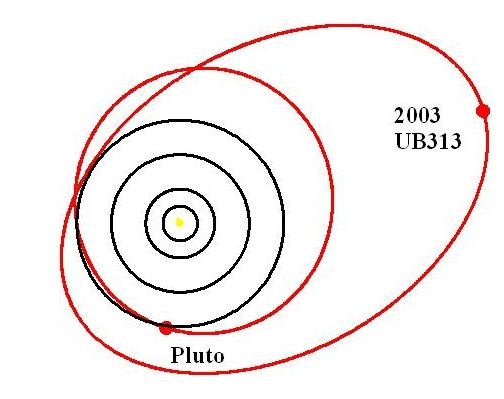
Brown et al (2005, in pdf) Although Eris has a very large orbit around the Sun, it appears to move as close as Pluto and Neptune at its closest approach to our Sun. (more) Based on analysis of infrared sunlight reflected off of Eris' surface, the object appears to be almost white in appearance, while Pluto is "moderately" red. Because Eris is currently so far away from the Sun, methane and nitrogen may have frozen out of the atmosphere as a coating of frost on its surface like Pluto and its interior is likely to be composed of rock and ice like Pluto and other Edgeworth-Kuiper objects (EKOs). During the period of Eris' discovery and astronomical analysis, two other EKOs (2003 EL61 and 2005 FY9) with around two-thirds to three-fourths or more of Pluto's diameter were also located at around 52 AUs from Sol. (Updates and images on all three objects are available from astronomer Mike Brown's discovery page. More information and links can be found at Astronomy Picture of the Day's web pages for July 31 and August 1, 2005.) SOURCE: Bertoldi et al, Universität Bonn |
||
|
..
CALTECH PAPERS NASA APOD GEMINI OBSERVATORY OTHERS |
||
| FAIR USE NOTICE: This page contains copyrighted material the use of which has not been specifically authorized by the copyright owner. Pegasus Research Consortium distributes this material without profit to those who have expressed a prior interest in receiving the included information for research and educational purposes. We believe this constitutes a fair use of any such copyrighted material as provided for in 17 U.S.C § 107. If you wish to use copyrighted material from this site for purposes of your own that go beyond fair use, you must obtain permission from the copyright owner. | ||
|
|
